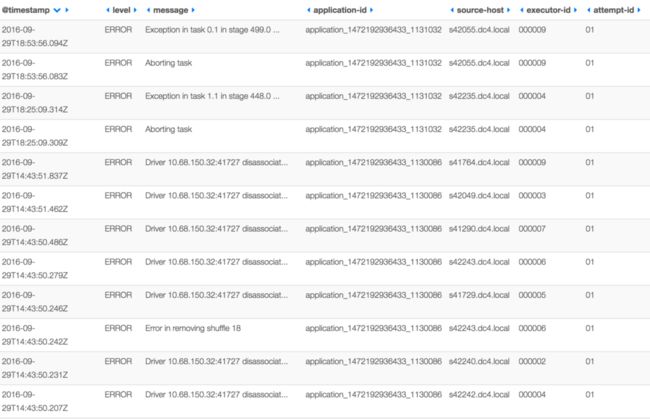对于长时间运行的Spark Streaming作业,一旦提交到YARN群集便需要永久运行,直到有意停止。任何中断都会引起严重的处理延迟,并可能导致数据丢失或重复。YARN和Apache Spark都不是为了执行长时间运行的服务而设计的。但是,它们已经成功地满足了近实时数据处理作业的常驻需求。成功并不一定意味着没有技术挑战。
这篇博客总结了在安全的YARN集群上,运行一个关键任务且长时间的Spark Streaming作业的经验。您将学习如何将Spark Streaming应用程序提交到YARN群集,以避免在值班时候的不眠之夜。
Fault tolerance
在YARN集群模式下,Spark驱动程序与Application Master(应用程序分配的第一个YARN容器)在同一容器中运行。此过程负责从YARN 驱动应用程序和请求资源(Spark执行程序)。重要的是,Application Master消除了在应用程序生命周期中运行的任何其他进程的需要。即使一个提交Spark Streaming作业的边缘Hadoop节点失败,应用程序也不会受到影响。
要以集群模式运行Spark Streaming应用程序,请确保为spark-submit命令提供以下参数:
spark-submit --master yarn --deploy-mode cluster
由于Spark驱动程序和Application Master共享一个JVM,Spark驱动程序中的任何错误都会阻止我们长期运行的工作。幸运的是,可以配置重新运行应用程序的最大尝试次数。设置比默认值2更高的值是合理的(从YARN集群属性yarn.resourcemanager.am.max尝试中导出)。对我来说,4工作相当好,即使失败的原因是永久性的,较高的值也可能导致不必要的重新启动。
spark-submit --master yarn --deploy-mode cluster --conf spark.yarn.maxAppAttempts=4
如果应用程序运行数天或数周,而不重新启动或重新部署在高度使用的群集上,则可能在几个小时内耗尽4次尝试。为了避免这种情况,尝试计数器应该在每个小时都重置。
spark-submit --master yarn --deploy-mode cluster \
--conf spark.yarn.maxAppAttempts=4 \
--conf spark.yarn.am.attemptFailuresValidityInterval=1h
另一个重要的设置是在应用程序发生故障之前executor失败的最大数量。默认情况下是max(2 * num executors,3),非常适合批处理作业,但不适用于长时间运行的作业。该属性具有相应的有效期间,也应设置。
spark-submit --master yarn --deploy-mode cluster \
--conf spark.yarn.maxAppAttempts=4 \
--conf spark.yarn.am.attemptFailuresValidityInterval=1h \
--conf spark.yarn.max.executor.failures={8 * num_executors} \
--conf spark.yarn.executor.failuresValidityInterval=1h
对于长时间运行的作业,您也可以考虑在放弃作业之前提高任务失败的最大数量。默认情况下,任务将重试4次,然后作业失败。
spark-submit --master yarn --deploy-mode cluster \
--conf spark.yarn.maxAppAttempts=4 \
--conf spark.yarn.am.attemptFailuresValidityInterval=1h \
--conf spark.yarn.max.executor.failures={8 * num_executors} \
--conf spark.yarn.executor.failuresValidityInterval=1h \
--conf spark.task.maxFailures=8
Performance
当Spark Streaming应用程序提交到集群时,必须定义运行作业的YARN队列。我强烈建议使用YARN Capacity Scheduler并将长时间运行的作业提交到单独的队列。没有一个单独的YARN队列,您的长时间运行的工作迟早将被的大量Hive查询抢占。
spark-submit --master yarn --deploy-mode cluster \
--conf spark.yarn.maxAppAttempts=4 \
--conf spark.yarn.am.attemptFailuresValidityInterval=1h \
--conf spark.yarn.max.executor.failures={8 * num_executors} \
--conf spark.yarn.executor.failuresValidityInterval=1h \
--conf spark.task.maxFailures=8 \
--queue realtime_queue
Spark Streaming工作的另一个重要问题是保持处理时间的稳定性和高度可预测性。处理时间应保持在批次持续时间以下以避免延误。我发现Spark的推测执行有很多帮助,特别是在繁忙的群集中。当启用推测性执行时,批处理时间更加稳定。只有当Spark操作是幂等时,才能启用推测模式。
spark-submit --master yarn --deploy-mode cluster \
--conf spark.yarn.maxAppAttempts=4 \
--conf spark.yarn.am.attemptFailuresValidityInterval=1h \
--conf spark.yarn.max.executor.failures={8 * num_executors} \
--conf spark.yarn.executor.failuresValidityInterval=1h \
--conf spark.task.maxFailures=8 \
--queue realtime_queue \
--conf spark.speculation=true
Security
在安全的HDFS群集上,长时间运行的Spark Streaming作业由于Kerberos票据到期而失败。没有其他设置,当Spark Streaming作业提交到集群时,会发布Kerberos票证。当票证到期时Spark Streaming作业不能再从HDFS写入或读取数据。
在理论上(基于文档),应该将Kerberos主体和keytab作为spark-submit命令传递:
spark-submit --master yarn --deploy-mode cluster \
--conf spark.yarn.maxAppAttempts=4 \
--conf spark.yarn.am.attemptFailuresValidityInterval=1h \
--conf spark.yarn.max.executor.failures={8 * num_executors} \
--conf spark.yarn.executor.failuresValidityInterval=1h \
--conf spark.task.maxFailures=8 \
--queue realtime_queue \
--conf spark.speculation=true \
--principal user/hostname@domain \
--keytab /path/to/foo.keytab
实际上,由于几个错误(HDFS-9276, SPARK-11182)必须禁用HDFS缓存。如果没有,Spark将无法从HDFS上的文件读取更新的令牌。
spark-submit --master yarn --deploy-mode cluster \
--conf spark.yarn.maxAppAttempts=4 \
--conf spark.yarn.am.attemptFailuresValidityInterval=1h \
--conf spark.yarn.max.executor.failures={8 * num_executors} \
--conf spark.yarn.executor.failuresValidityInterval=1h \
--conf spark.task.maxFailures=8 \
--queue realtime_queue \
--conf spark.speculation=true \
--principal user/hostname@domain \
--keytab /path/to/foo.keytab \
--conf spark.hadoop.fs.hdfs.impl.disable.cache=true
Mark Grover指出,这些错误只影响在HA模式下配置了NameNodes的HDFS集群。
Logging
访问Spark应用程序日志的最简单方法是配置Log4j控制台追加程序,等待应用程序终止并使用yarn logs -applicationId [applicationId]命令。不幸的是终止长时间运行的Spark Streaming作业来访问日志是不可行的。
我建议安装和配置Elastic,Logstash和Kibana(ELK套装)。ELK的安装和配置是超出了这篇博客的范围,但请记住记录以下上下文字段:
YARN application id
YARN container hostname
Executor id (Spark driver is always 000001, Spark executors start from 000002)
YARN attempt (to check how many times Spark driver has been restarted)
Log4j配置使用Logstash特定的appender和布局定义应该传递给spark-submit命令:
spark-submit --master yarn --deploy-mode cluster \
--conf spark.yarn.maxAppAttempts=4 \
--conf spark.yarn.am.attemptFailuresValidityInterval=1h \
--conf spark.yarn.max.executor.failures={8 * num_executors} \
--conf spark.yarn.executor.failuresValidityInterval=1h \
--conf spark.task.maxFailures=8 \
--queue realtime_queue \
--conf spark.speculation=true \
--principal user/hostname@domain \
--keytab /path/to/foo.keytab \
--conf spark.hadoop.fs.hdfs.impl.disable.cache=true \
--conf spark.driver.extraJavaOptions=-Dlog4j.configuration=file:log4j.properties \
--conf spark.executor.extraJavaOptions=-Dlog4j.configuration=file:log4j.properties \
--files /path/to/log4j.properties
最后,Spark Job的Kibana仪表板可能如下所示:
Monitoring
长时间运行的工作全天候运行,所以了解历史指标很重要。Spark UI仅在有限数量的批次中保留统计信息,并且在重新启动后,所有度量标准都消失了。再次,需要外部工具。我建议安装Graphite用于收集指标和Grafana来建立仪表板。
首先,Spark需要配置为将指标报告给Graphite,准备metrics.properties文件:
*.sink.graphite.class=org.apache.spark.metrics.sink.GraphiteSink
*.sink.graphite.host=[hostname]
*.sink.graphite.port=[port]
*.sink.graphite.prefix=some_meaningful_name
driver.source.jvm.class=org.apache.spark.metrics.source.JvmSource
executor.source.jvm.class=org.apache.spark.metrics.source.JvmSource
Graceful stop
最后一个难题是如何以优雅的方式停止部署在YARN上的Spark Streaming应用程序。停止(甚至杀死)YARN应用程序的标准方法是使用命令yarn application -kill [applicationId]。这个命令会停止Spark Streaming应用程序,但这可能发生在批处理中。因此,如果该作业是从Kafka读取数据然后在HDFS上保存处理结果,并最终提交Kafka偏移量,当作业在提交偏移之前停止工作时,您应该预见到HDFS会有重复的数据。
解决优雅关机问题的第一个尝试是在关闭程序时回调Spark Streaming Context的停止方法。
sys.addShutdownHook {
streamingContext.stop(stopSparkContext = true, stopGracefully = true)
}
令人失望的是,由于Spark应用程序几乎立即被杀死,一个退出回调函数来不及完成已启动的批处理任务。此外,不能保证JVM会调用shutdown hook。
在撰写本博客文章时,唯一确认的YARN Spark Streaming应用程序的确切方法是通知应用程序关于计划关闭,然后以编程方式停止流式传输(但不是关闭挂钩)。命令yarn application -kill 如果通知应用程序在定义的超时后没有停止,则应该仅用作最后手段。
可以使用HDFS上的标记文件(最简单的方法)或使用驱动程序上公开的简单Socket / HTTP端点(复杂方式)通知应用程序。
因为我喜欢KISS原理,下面你可以找到shell脚本伪代码,用于启动/停止Spark Streaming应用程序使用标记文件:
start() {
hdfs dfs -touchz /path/to/marker/my_job_unique_name
spark-submit ...
}
stop() {
hdfs dfs -rm /path/to/marker/my_job_unique_name
force_kill=true
application_id=$(yarn application -list | grep -oe "application_[0-9]*_[0-9]*"`)
for i in `seq 1 10`; do
application_status=$(yarn application -status ${application_id} | grep "State : \(RUNNING\|ACCEPTED\)")
if [ -n "$application_status" ]; then
sleep 60s
else
force_kill=false
break
fi
done
$force_kill && yarn application -kill ${application_id}
}
在Spark Streaming应用程序中,后台线程应该监视标记文件,当文件消失时停止上下文调用
streamingContext.stop(stopSparkContext = true, stopGracefully = true).
Summary
可以看到,部署在YARN上的关键任务Spark Streaming应用程序的配置相当复杂。以上提出的技术,由一些非常聪明的开发人员经过漫长而冗长乏味的迭代学习。最终,部署在高可用的YARN集群上的长期运行的Spark Streaming应用非常稳定。
原文地址:http://mkuthan.github.io/blog/2016/09/30/spark-streaming-on-yarn/
